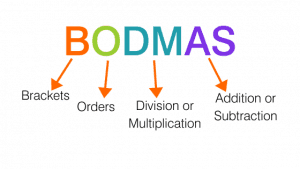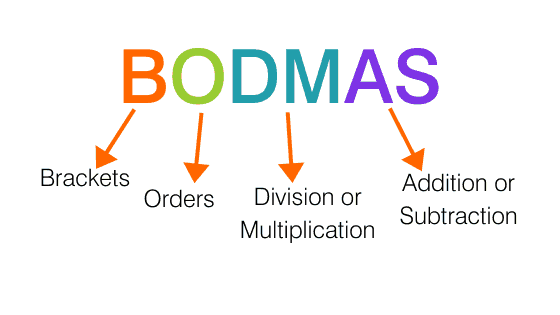What is BODMAS?
To put it simply, BODMAS is a way to help you remember what order mathematical calculations should be completed in. It’s often first introduced to school children in year 6. But it’s also really helpful to use at GCSE level or Functional Skills maths as well.
There are lots of variations of the acronym including BODMAS, BIDMAS, PEMDAS and BEDMAS. But for the purpose of this article, we’ll be using BODMAS. Most of these variations mean relatively the same thing but PEDMAS is more commonly used in the USA.
So, what does BODMAS stand for?

| Step 1 | Brackets | ( ) |
| Step 2 | Orders (indices in BIDMAS) | Orders are powers or square roots. For example 23 means multiplying the number 3 times 2x2x2=8. Or square root works in the opposite so the square root of 4 is 2. |
| Step 3 | Division | ÷ |
| Multiplication | x | |
| Step 4 | Addition | + |
| Subtraction | - |
So, when you perform any mathematical equation involving several different operations, it should be done in the order of BODMAS.
Division and multiplication have been grouped together as they are on the same level. Or if there is both division AND multiplication, complete as they appear from left to right. The same goes for addition and subtraction.
In other words, when performing a calculation:
- Complete anything in brackets first
- Next do any orders/indices
- Then do division or multiplication (or if there is division AND multiplication, complete from left to right).
- Finally, addition or subtraction (or if there is both, complete from left to right).
Let’s put this into practise. Here are some BODMAS examples:
| Calculation | Order of completion (BODMAS) | Answer |
|---|---|---|
| 4 x (10 - 2) = | Complete the brackets first which is 10 - 2 = 8. Then the multiplication of 4 x 8 = 12 | 12 |
| 12 - 4 + 10 = | Addition and subtraction have the same level of order so complete from left to right. 12 - 4 = 8 then + 10 = 18 | 18 |
| 4 + 62 = | Complete the power first which is 6 x 6 = 36. Then the addition which is 4 + 36 = 40 | 40 |
| 32 - 3 x 5 = | Complete multiplication first so 4 x 5 = 15 then subtraction next so 32 - 15 = 17 | 17 |
| 8 x 5 ÷ 4 = | Multiplication and division have the same level of order so complete from left to right. 8 x 5 = 40 then ÷ 4 = 10 | 10 |
Top Tip! Some scientific calculators will use the BODMAS rules when inputting an equation however, not all do. So if you have a simple calculator, it’s best to work out the equation step by step.
There are plenty more examples to be found online or feel free to make up your own BODMAS questions and try them out!
Here’s a really tricky equation to sink your teeth into which includes all of the elements in BODMAS. Give it a go working through the BODMAS rules, one step at a time. The solution and explanation can be found at the end.
Question:
2 x 20 ÷ 2 + (3 + 4) x 32 – 6 + 15 = ??
Answer:
- Brackets first so (3 + 4 = 7) which makes the equation 2 x 20 ÷ 2 + 7 x 32 – 6 + 15 = ??
- Then the orders so 32 = 9 which makes the equation 2 x 20 ÷ 2 + 7 x 9 – 6 + 15 = ??
- Next division and multiplication from left to right so 2 x 20 = 40 ÷ 2 = 20 then 7 x 9 = 63 which makes the equation 20 + 63 – 6 + 15 = ??
- Finally, addition and subtraction from left to right so 20 + 63 = 83 – 6 = 77 + 15 = 92 which makes the answer 92.
Do you want to learn more about BODMAS? Subscribe to our online Functional Skills Maths course. The course covers this topic and many more topics for just £14 per month!


